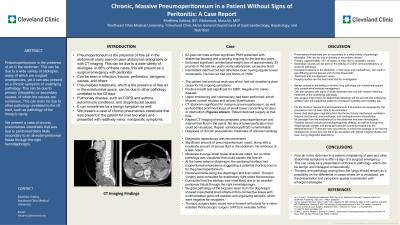Back


Poster Session B - Monday Morning
Category: Colon
B0127 - Chronic, Massive Pneumoperitoneum in a Patient Without Signs of Peritonitis: A Case Report
Monday, October 24, 2022
10:00 AM – 12:00 PM ET
Location: Crown Ballroom

Has Audio

Matthew Kubina, BS
Northeast Ohio Medical University
Rootstown, OH
Presenting Author(s)
Matthew Kubina, BS1, Mohamad Mouchli, MD2
1Northeast Ohio Medical University, Rootstown, OH; 2Cleveland Clinic Akron General, Akron, OH
Introduction: Pneumoperitoneum is the presence of free air in the abdominal cavity. This alarming symptom can be due to a wide variety of etiologies, including infection, trauma, perforation, and others. However, pneumatosis intestinalis, which is the presence of free air in the extraluminal space, can be due to other pathology unrelated to the GI tract. It can be seen in pulmonary disease, such as COPD and asthma, autoimmune conditions, and drug-induced causes as well. It can present with more benign symptoms. We present a case of chronic pneumatosis intestinalis that was present in the patient for over two years and presented with relatively minor, nonspecific symptoms.
Case Description/Methods: This patient was a 62-year-old male who presented with concerns of bloating and cramping, ongoing for two years. Previous work-ups had not revealed a clear cause for his ongoing symptoms. He had undergone CT of the abdomen, which was significant for massive pneumoperitoneum, as well as fluid-filled prominent loops of small bowel concerning for ileus or obstruction. There was no site of bowel perforation that could be visualized. Upper endoscopy and colonoscopy had been performed, which showed normal mucosa and colonic diverticulosis.
After further workup at an additional institution, diagnostic laparotomy was recommended to further evaluate his small bowel. At the lower anterior diaphragm, the peritoneal surface had subperitoneal emphysema, suggesting a potential thoracic source for the pneumoperitoneum. Thoracic surgery were consulted for exploratory right-sided thoracoscopy since he was noted to have peritoneal blebs along the diaphragm most notably, with one also being identified on the liver. It was concluded that the etiology was most likely due to an alveolar-peritoneal fistula through the right hemidiaphragm.
Discussion: Pneumatosis Intestinalis can be a benign presenting symptom. Pneumoperitoneum can be due to primary (idiopathic) or secondary causes. Secondary causes are numerous, and these can be seen in the setting of COPD, immunodeficiency, or acute GI pathology. Increased pressure in the abdomen or the mediastinum can result in gas diffusing across tissues and into the bowel wall. Treatment and management varies depending on the patient's presentation. More serious abdominal pathology requires surgical management, while benign causes in the setting of chronic lung pathology can be asymptomatic, or present with mild symptoms that require only conservative medical management.

Disclosures:
Matthew Kubina, BS1, Mohamad Mouchli, MD2. B0127 - Chronic, Massive Pneumoperitoneum in a Patient Without Signs of Peritonitis: A Case Report, ACG 2022 Annual Scientific Meeting Abstracts. Charlotte, NC: American College of Gastroenterology.
1Northeast Ohio Medical University, Rootstown, OH; 2Cleveland Clinic Akron General, Akron, OH
Introduction: Pneumoperitoneum is the presence of free air in the abdominal cavity. This alarming symptom can be due to a wide variety of etiologies, including infection, trauma, perforation, and others. However, pneumatosis intestinalis, which is the presence of free air in the extraluminal space, can be due to other pathology unrelated to the GI tract. It can be seen in pulmonary disease, such as COPD and asthma, autoimmune conditions, and drug-induced causes as well. It can present with more benign symptoms. We present a case of chronic pneumatosis intestinalis that was present in the patient for over two years and presented with relatively minor, nonspecific symptoms.
Case Description/Methods: This patient was a 62-year-old male who presented with concerns of bloating and cramping, ongoing for two years. Previous work-ups had not revealed a clear cause for his ongoing symptoms. He had undergone CT of the abdomen, which was significant for massive pneumoperitoneum, as well as fluid-filled prominent loops of small bowel concerning for ileus or obstruction. There was no site of bowel perforation that could be visualized. Upper endoscopy and colonoscopy had been performed, which showed normal mucosa and colonic diverticulosis.
After further workup at an additional institution, diagnostic laparotomy was recommended to further evaluate his small bowel. At the lower anterior diaphragm, the peritoneal surface had subperitoneal emphysema, suggesting a potential thoracic source for the pneumoperitoneum. Thoracic surgery were consulted for exploratory right-sided thoracoscopy since he was noted to have peritoneal blebs along the diaphragm most notably, with one also being identified on the liver. It was concluded that the etiology was most likely due to an alveolar-peritoneal fistula through the right hemidiaphragm.
Discussion: Pneumatosis Intestinalis can be a benign presenting symptom. Pneumoperitoneum can be due to primary (idiopathic) or secondary causes. Secondary causes are numerous, and these can be seen in the setting of COPD, immunodeficiency, or acute GI pathology. Increased pressure in the abdomen or the mediastinum can result in gas diffusing across tissues and into the bowel wall. Treatment and management varies depending on the patient's presentation. More serious abdominal pathology requires surgical management, while benign causes in the setting of chronic lung pathology can be asymptomatic, or present with mild symptoms that require only conservative medical management.

Figure: Pneumatosis Intestinalis on CT Scan
Disclosures:
Matthew Kubina indicated no relevant financial relationships.
Mohamad Mouchli indicated no relevant financial relationships.
Matthew Kubina, BS1, Mohamad Mouchli, MD2. B0127 - Chronic, Massive Pneumoperitoneum in a Patient Without Signs of Peritonitis: A Case Report, ACG 2022 Annual Scientific Meeting Abstracts. Charlotte, NC: American College of Gastroenterology.
